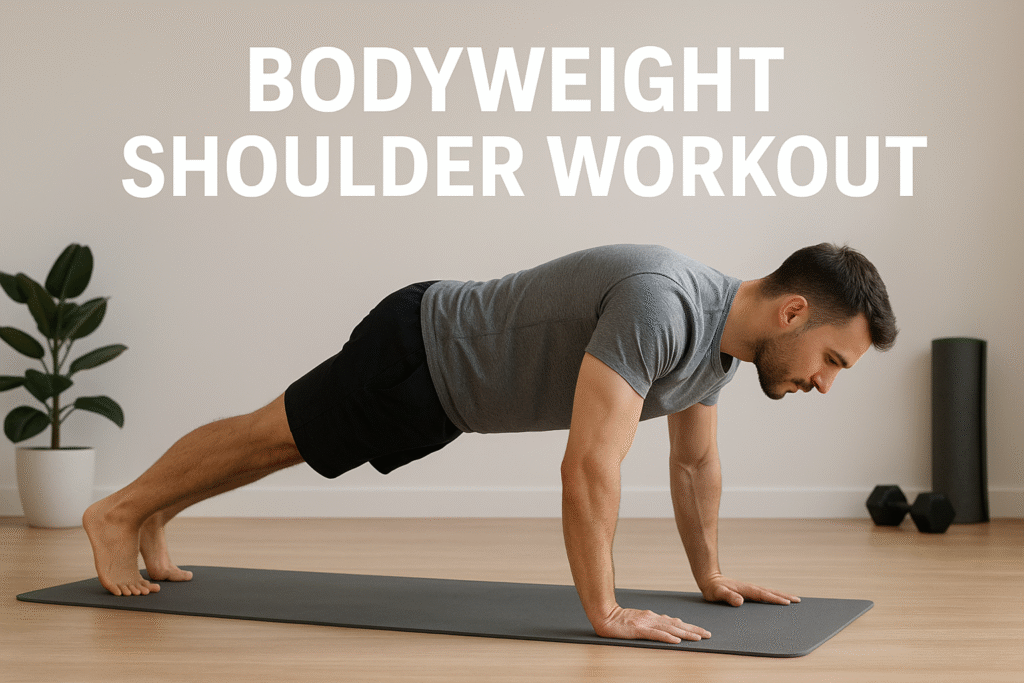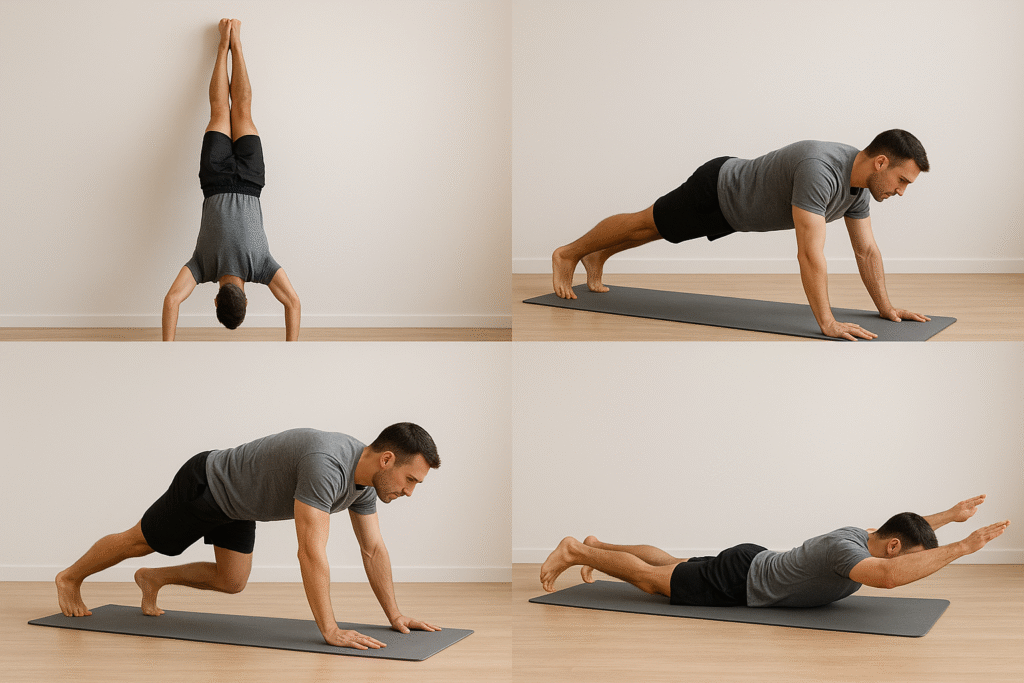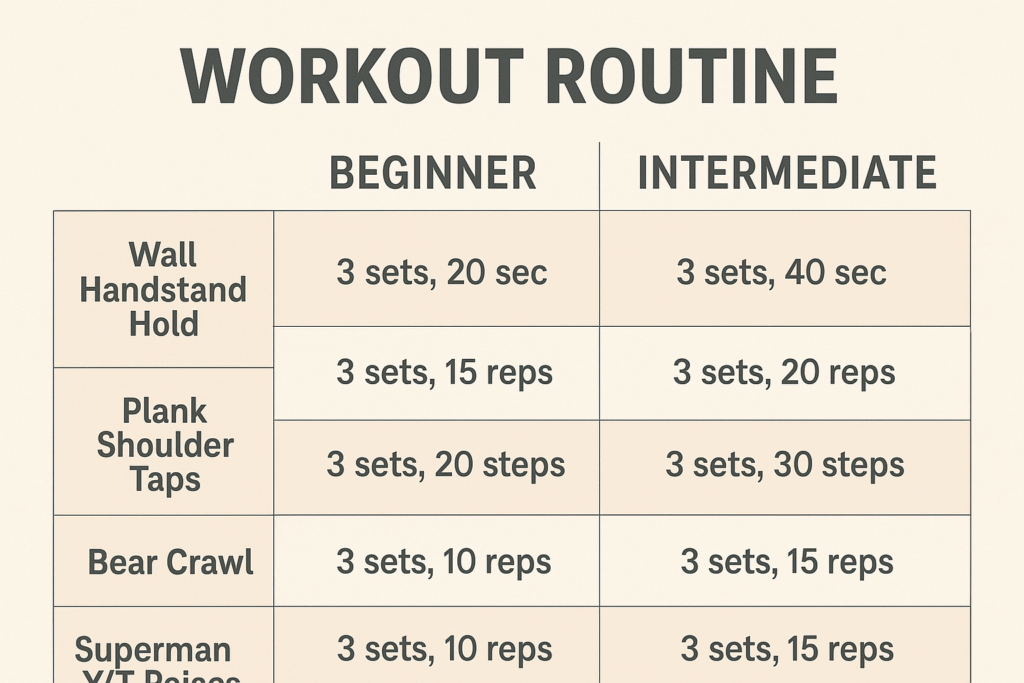
Strong shoulders aren’t just for looks—they stabilize your entire upper body, support your posture, and protect you from injuries. The good news? You don’t need a gym or fancy equipment to train them effectively. With the right bodyweight shoulder workout at home, you can build impressive strength and mobility using only your body’s resistance.
A bodyweight shoulder workout at home is one of the most effective ways to build strength and stability without needing any gym equipment. By focusing on exercises like pike push-ups, wall walks, and plank shoulder taps, you can sculpt strong deltoids and improve posture right from your living room. This type of bodyweight shoulder workout at home also enhances joint mobility and helps prevent common shoulder injuries caused by poor posture or weak stabilizer muscles. Whether you’re a beginner or advanced athlete, bodyweight training offers endless progression through increased time under tension or advanced variations like handstand holds.
According to Healthline, consistent shoulder training improves overall upper-body performance and endurance. Similarly, Verywell Fit emphasizes how simple home workouts can match gym-based results when done correctly. To maximize gains from your bodyweight shoulder workout at home, train at least twice weekly, maintain proper form, and allow adequate recovery. Over time, this routine will not only strengthen your shoulders but also enhance your entire body’s functional strength and appearance.
Benefits of Bodyweight Shoulder Workout
Training shoulders with your own body weight offers multiple advantages beyond convenience:
1. Builds Strength Without Equipment
Bodyweight movements engage stabilizer muscles, improving strength and endurance. Push-ups, planks, and handstands challenge your deltoids, traps, and rotator cuff—all without weights.
2. Improves Posture and Stability
Strong shoulders pull the upper back into alignment, reducing forward rounding from daily activities like computer work or driving.
3. Reduces Shoulder Injury Risk
Controlled bodyweight exercises strengthen small stabilizers around the joint, lowering the risk of impingement and strains.
4. Fits Any Schedule
You can train anywhere—bedroom, balcony, or park. No excuses.
Warm-Up (3–5 Minutes)
Before hitting any shoulder workout at home, a proper warm-up prepares the joints and muscles:
- Arm Circles: 20 seconds forward, 20 backward.
- Shoulder Rolls: Roll shoulders up, back, and down for 30 seconds.
- Wall Angels: Stand with back to wall, slide arms up and down for 10 reps.
This boosts blood flow and mobility, ensuring safe and efficient training.
Top 8 Bodyweight Shoulder Exercises (Step-by-Step)

These are the cornerstone moves of any effective bodyweight shoulder workout.
1. Pike Push-Ups
How: Start in downward dog. Bend elbows, lower your head toward the floor, and push back up.
Muscles Worked: Front and side delts, triceps, upper chest.
Sets/Reps: 3 sets of 10–15.
Variation: Elevate feet for more intensity.
2. Wall Walks / Wall Handstand Holds
How: Walk your feet up the wall while walking your hands toward it until in a handstand. Hold or walk back down.
Muscles Worked: Shoulders, traps, core.
Sets/Reps: 3 rounds of 3–5 walks or 30-sec holds.
Variation: Hold static wall handstands for beginners.
3. Plank Shoulder Taps
How: From plank, tap each shoulder while keeping hips steady.
Muscles Worked: Front delts, core, triceps.
Sets/Reps: 3 sets of 20 taps.
Variation: Perform from knees for easier control.
4. Bear Crawls
How: From all fours, lift knees slightly and crawl forward.
Muscles Worked: Front delts, core, chest, legs.
Sets/Reps: 3 rounds of 20–30 seconds.
5. Superman Y/T Raises
How: Lie face down, lift arms into “Y” or “T” position, squeeze shoulder blades.
Muscles Worked: Rear delts, traps, rhomboids.
Sets/Reps: 3 sets of 12–15.
6. Incline Push-Ups (Hands Elevated)
How: Hands on a bench or counter. Lower chest and push up.
Muscles Worked: Front delts, chest, triceps.
Sets/Reps: 3 sets of 10–12.
7. Arm Circles & Static Holds
How: Extend arms, make small controlled circles. Alternate with static holds.
Muscles Worked: Shoulder endurance and mobility.
Sets/Reps: 2–3 sets of 30–60 seconds each direction.
8. Inchworm Walkouts
How: Stand tall, walk hands forward into plank, then walk back.
Muscles Worked: Shoulders, chest, core.
Sets/Reps: 3 rounds of 8–10 reps.
Sample Shoulder Workout Routine (Beginner & Intermediate)

Beginner Routine
| Exercise | Sets | Reps | Rest |
|---|---|---|---|
| Arm Circles | 2 | 30 sec | 20 sec |
| Pike Push-Ups | 2 | 10 | 30 sec |
| Plank Shoulder Taps | 2 | 20 | 30 sec |
| Superman Raises | 2 | 12 | 30 sec |
| Inchworm Walkouts | 2 | 8 | 30 sec |
Intermediate Routine
| Exercise | Rounds | Duration | Rest |
|---|---|---|---|
| Wall Walks | 3 | 30 sec | 45 sec |
| Pike Push-Ups | 3 | 15 | 45 sec |
| Bear Crawls | 3 | 30 sec | 45 sec |
| Y/T Raises | 3 | 15 | 45 sec |
| Static Arm Holds | 3 | 45 sec | 30 sec |
Repeat 2–3 times weekly for optimal results.
Tips for Progression & Safety
- Focus on form before adding volume.
- Increase hold time or slow tempo to progress.
- Train 2–3 days per week with rest between sessions.
- Add variety to target all heads of the deltoid.
- Cool down with light stretching post-workout.
Common Mistakes to Avoid
- Shrugging shoulders during push-ups—keep them down and back.
- Rushing reps—control each movement to engage the right muscles.
- Skipping warm-up—leads to stiffness and higher injury risk.
- Overtraining—shoulders need recovery to grow stronger.
FAQs
1. Can I build big shoulders with just bodyweight?
Yes. With progressive overload—longer holds, more reps, harder variations—you can gain significant strength and muscle.
2. How often should I do a bodyweight shoulder workout?
2–3 times weekly is ideal for most people.
3. Do I need equipment for shoulder training at home?
No. Exercises like pike push-ups and wall walks provide enough resistance.
4. What’s the best time to train shoulders?
Any time you can train consistently. Evenings work best for most due to flexibility and energy levels.
5. Should I combine this with other workouts?
Yes. Pair with core and leg sessions for balanced fitness.
6. Can beginners try handstand holds?
Start with wall support and short holds, then progress as control improves.
Conclusion
A bodyweight shoulder workout at home builds strength, posture, and endurance—no equipment required. With just a few moves and consistency, you can develop strong, stable shoulders that enhance every movement you make.
👉 Next Steps:
- Try our Best Bodyweight Arm Exercises for balanced upper-body strength.
- Stay tuned for the upcoming Bodyweight Core Workout Routine guide.


One Response